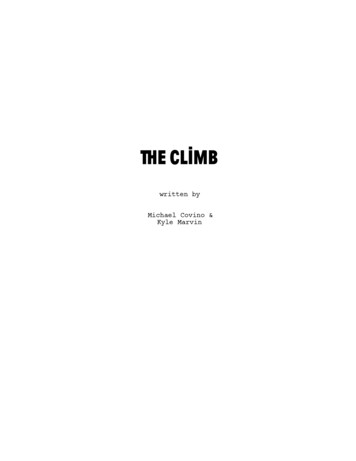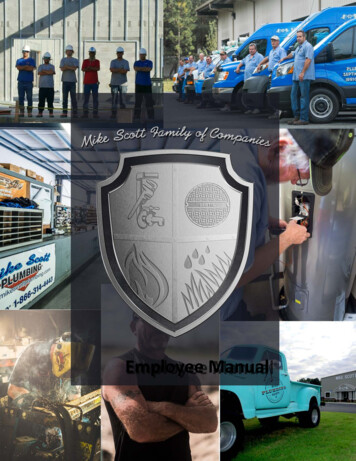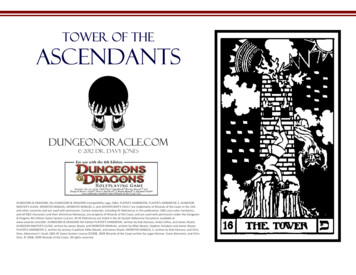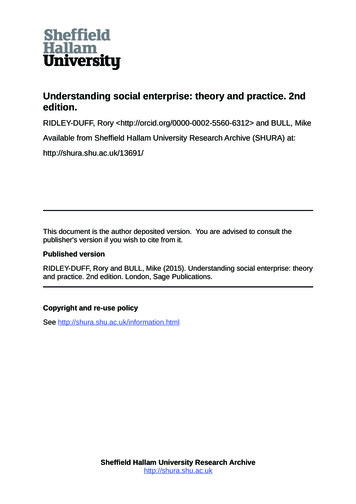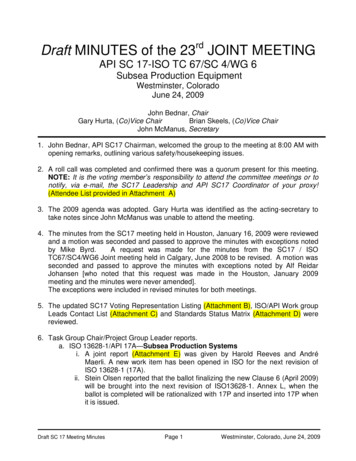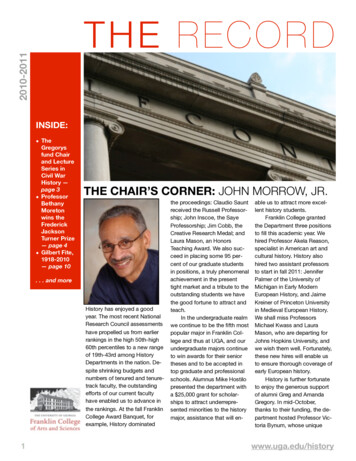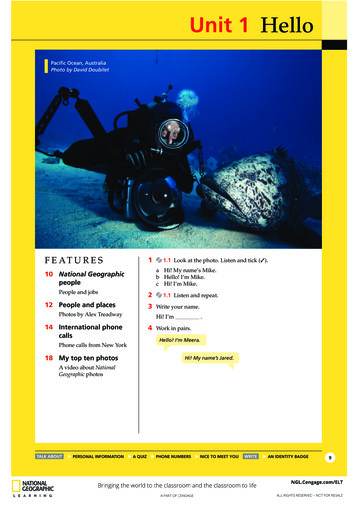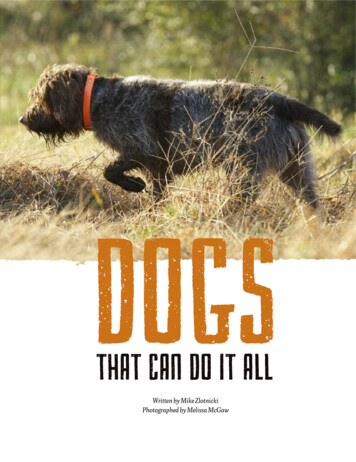
Transcription
Written by Mike ZlotnickiPhotographed by Melissa McGaw
Waterfowl, upland birds and tracking game areall in a day’s work for the breeds (and people) ofthe North American VersatileHunting Dog Association.ebster ’s defines“versatile” as“changing orfluctuating readily; embracing a variety of subjects,fields, or skills.” We see it daily in a variety of things.Baseball has the “five-tool player,” an athlete who canhit for power, hit for average, run fast, throw hard anddeftly field. Cutlery has the Swiss Army Knife, a tool thatcan cut, file, tighten, sharpen, snip or saw. Other kniveswith multi-tools, like the Leatherman, take the termversatile even a step further. The hunting world has thebreeds of the North American Versatile Hunting DogAssociation (NAVHDA).These dogs, mostly of continental European descent,are expected to find and retrieve game on land, find andretrieve game in water, track furred or feathered game onland and be cooperative yet independent while doing so.My interest in bird dogs started with Jim Kjelgaard’sbook “Big Red” and the rest of his trilogy in grade school.“Where the Red Fern Grows” (which should be issued toevery child at birth) further curried my interest in hunting dogs. While in high school one of my football coaches, Allen Johnson of Sumter, S.C., rescued a lemon-andwhite pointer named Molly. I adopted Molly and weterrorized quail whenever we had the chance.Later, after college and marriage, I bought a Germanshorthaired pointer from an old high school friend inOklahoma. Kate was a big bird-finding machine, but hadno interest in water work or retrieving and her disposition left a little to be desired, especially with other dogs.When we had to put her down in October of 2011, ourfamily mourned her passing.And I decided to get serious. While working for anewspaper, I covered a NAVHDA winter test presentedby the Carolinas Chapter at Johnson Marsh ShootingPreserve and the performance of those dogs on land andin water was impressive. The thought of one dog doing itall was intriguing. I began researching breeders in earnest,which led me to Friedelsheim German shorthairedPointing and retrieving upland birds are only part of what isexpected of NAVHDA dogs. Water work and tracking are alsopart of the package, and the dogs are tested against a standard,not each other.september october 2013 winc11
dog owners —were the primary focuses of theChapter. We also found out that the membership is as varied as the breeds owned.The ProfessorJesse Grimes of Garner is one of the founding members of the Carolinas Chapter and hasserved in just about every position offered bythe club. He helped found the chapter afteranswering an advertisement in a newspaperplaced by the late Roy Thillberg of Charlotte,searching for people interested in starting one.That was in 1995, and Grimes, a poultry professor at N.C. State University, has been activeever since.Growing up in Scotland Neck, Grimes wasaround bird dogs but hunted rabbits with beagles. He owned a springer spaniel in 1990while in college and then a Deutsch drahthaarnamed Sally. Since then, he’s owned a smorgasbord of mostly continental breeds —pointers, a French Brittany spaniel, two Germanwirehairs and a Deutsch kurzaar.Grimes personifies the majority ofNAVHDA members. “My purpose in joiningNAVHDA was to develop my dogs for hunting,” he said. “The testing process is a journeyfor me. It tells me where I am in my training.NAVHDA is also for breeders to evaluate theirbreeding processes for each breed. The testingstarted with breeders. Now, it’s as much ahandlers’ club.”The SoldierDr. Jesse Grimes of Garner sends hisGerman shorthaired pointer (Deutschkurzhaar) Della into a pond for a waterretrieve. A Deutsch kurzhaar is a Germanshorthaired pointer that is registeredwith the Deutsch Kurzhaar Verband inGermany and is tested to that breedclub’s standards. Opposite page, VivianWiese-Hansen of Raleigh, her Germanshorthair Tucker, and Scott Caldwell ofLillington discuss upland bird trainingduring a Carolinas Chapter training day.12september october 2013 wincpointers (GSPs) in Maryland. I’d been visitingthe website for a while and the site’s photogalleries displayed a nice mix of upland andwaterfowl hunts. It was apparent that a lot ofthought went into the breeding program toproduce versatile dogs. Photos also showeddogs interacting with the breeder ’s children.As the father of three girls, sound temperament in a dog was paramount, even more thanconformation or drive.When an announcement of a plannedbreeding was posted I contacted DonnieEbersole, the owner. Several lengthy emailsand phone conversations ensued, and aboutsix months later my wife, Renee, and I drovehome with Friedelsheim’s Tar Heel Annie.We quickly joined the Carolinas Chapterand learned that training dogs — and trainingMaster Sergeant Scott Caldwell grew up withLabrador retrievers and “flushing” Brittanyspaniels in upstate New York but is a relativenewcomer to NAVHDA. “Back in the 1996 – 97time frame I returned from deployment andmy family bought me a guided preserve huntwith Tony Wooley at Cow Run Farms inCandor,” said Caldwell, who is assigned toSpecial Operations Command at Fort Bragg.“That was truly the first time I actually huntedover versatile pointing dogs for upland game. Iwas just amazed. They were German shorthairs. I won’t say they were perfectly trained,now that I’m older and have worked aroundother dogs. But I didn’t realize a dog couldbe trained to that level.”Within a year, Caldwell had purchased ashorthair named Ruger that would break ice
to retrieve mallards in the morning and thenwork guided upland hunts the rest of the day.Eventually his work with Ruger would lead totraining puppies and then to breeding shorthairs. Two years ago Caldwell purchasedan 80-acre spread outside of Lillington thatserves as the chapter’s training grounds, wheremonthly informal training days are held. Alarge pond allows for water work and fieldsare used for upland and tracking work. A lot oftraining, especially while the dogs are young,is in simple obedience, lacking in many gundogs. For some members this is their firstversatile dog and questions abound.“The gamekeepers in Europe wanted a trueversatile dog that could do blood trailing andupland as well as water,” he said. They bredand tested their dogs according to specificguidelines in Europe and the European testingis very strict. With that as a base, I think thatNAVHDA has brought that strict testing toour society. If you look at our average weekend hunter, I’d say about 85 percent don’t havethe time or money to have a Lab to retrieveducks, an English pointer to hunt birds anda beagle to hunt rabbits or other small game.For a guy like me, NAVHDA offers how totrain a dog.”Caldwell said that as a breeder and trainer,people would often purchase a puppy and say,“now what?” Caldwell would say “bring itback to me” or recommend a trainer. TheCarolinas Chapter offers a third option.The DietitianNot all chapter members are hunters. VivianWiese-Hansen, who works for the N.C. Deptof Health and Human Services as a nutritionprogram consultant, is a native of Quebec,Canada. She grew up with a father whofavored Brittanys in the field. A cousin gaveher Gina, a 7-year-old shorthair, in 2007.When Gina passed away she told herself “Iwill have another shorthair.” And into her lifecame Tucker, a ball of energy from field trialstock in Washington. “Strong drive, longer“Quite a bit of it is basic obedience, but you alsohave to understand and be able to read yourdog so you’ll know how to correct your dog.”range and smart as a whip,” she says of Tucker.“Very headstrong and covers a lot of ground.”There was a fairly steep learning curve forWiese-Hansen as an owner, but lots of walksand runs and training helped.“I’ve had a lot of fun and I wouldn’t havetraded these past two years for anything,” shesaid, citing the chapter and Tucker for theexperience. “I’ve had so much fun learningabout my dog, what his potential is and helping him learn what to do, teaching him. Butit’s also a learning process for me because Ididn’t know anything about training a huntingdog. Quite a bit of it is basic obedience, butyou also have to understand and be able toread your dog so you’ll know how to correctyour dog and know what is going to work.Having a dog and NAVDHA go hand-in-hand.”Wiese-Hansen said that a welcome offshoot of the monthly training days is how thechapter became a support group, whichspawned a sense of belonging and friendship. The social aspect is appealing; folks ofall types brought together through their dogs.When Tucker was 10 weeks old, WieseHansen met with Caldwell and formed a partnership with him; Caldwell teaching WieseHansen while Wiese-Hansen was trainingTucker. Caldwell would later handle Tuckerseptember october 2013 winc13
Above: Kevin Perez of Raleigh gets a kissfrom his Weimaraner after hydrating thedog during the upland portion of its Utilitytest. Right, the author steadies his puppyAnnie on point during a monthly NAVHDAtraining day.to a NAVHDA Natural Ability Prize I. WieseHansen now has enough experience to partnerwith other Chapter members for weekendtraining sessions as she readies Tucker forhis Utility Test in December.Getting ThereOur Annie proved to be a precocious pup, fullof drive and intelligence. You get what you payfor in breeding. Some of the training, like theupland work, was quite familiar, but some,like tracking, was not. I asked Grimes (one ofthe chapter ’s founders) about it and he suggested dragging a hot dog on a string to get herstarted. In only two hot dogs she was trackingnose on the ground. The little hints and tipsfrom chapter members can make the trainingside so much easier. As she progressed I wassure the Natural Ability test was in the bagand I expected a Prize I. I mean, a dog onlyhas to swim, hunt and point, and track, right?Even at a young 7 months I thought she’dbreeze through it. But as I learned, there aretraining days and there are testing days.Our test morning opened with Annie lacerating her gum and scraping her chest on ametal pole when I took her out to exercise. Sheshould have been on a leash. Rookie mistake.There were 10 puppies in her Natural Abilitygroup, and we were No. 10 in the order. Westarted with upland work and she seemed tosense it was “go time,” shaking off her soreness and carving up the bird field with nicequartering while garnering solid points. Someof the continental breeds are more methodicalin the field than pointers or setters, but Annieis not a plodder. A small gallery followed usalong with three judges. She aced the uplandtest. Next was swimming and she hesitatedat first to go in after the rubber bumper. Iglanced back at the gallery and my wife hadher hands covering her face. That’s nevergood. Annie eventually swam to the judges’satisfaction and also “passed” her coat andteeth exam. We broke for lunch and I had achance to talk to one of the senior judges,Mark Whalen of Poolesville, Md.“We want to see a dog do well; we wantdogs to pass,” he said between spoonfuls ofchili. “But, we don’t give out a NAVHDA prizelike a Christmas present. A dog has to earn it.
A Utility [prize] dog should be able to waterfowl hunt in the morning, upland hunt in theafternoon and track a wounded deer thenext morning.”He went on to explain some of the Utilitytests like the Duck Search, in which a dog isexpected to independently swim and searchup to 400 yards away for a duck that can’t beseen and can get no help from the handlerafter being sent. In NAVHDA, silence is golden. “We want the dogs to use this,” Whalensaid, tapping his nose.After lunch was the pheasant track, whena pheasant is released to run away and the dogis brought to the release site to track. Anniehad tracked hot dogs, dead ducks and livepheasants and I had a fair amount of confidence in her. But this was test day, and sureenough, she lost the track after 30 yards or soand when re-sent, couldn’t get any further. Atthe end of her time I leashed her and we madeour way back to Caldwell, where the handlersand guests gathered a little nervously to awaitthe public announcement of prizes. As fatewould have it, Annie had perfect scores untilthe pheasant track where she lost enoughpoints to knock her back to a Prize II(although her 108 points out of a 112 wouldnormally be a Prize I). Good enough for meat 7 months and hobbled some with minorinjuries. Now we’re looking toward Utility.I didn’t get a “bird dog” because I’m fooling myself about great upland hunting inNorth Carolina. But I love pointing breedsin general and shorthairs in particular. Withgrouse in the mountains, woodcock and snipein the Piedmont, some quail Down East andthe dove fields and duck swamps, one canparse together seven months of wing shooting in this state with a versatile dog. As muchas I loved my two dogs before Annie, I didn’tdo them any favors on the training side. Theywere more like “sporks” than Swiss ArmyKnives. I want a canine Victorinox. A do-itall dog. And with the help of the CarolinasChapter of the North American VersatileHunting Dog Association, good genes andsome determination, we’ll get there.Mike Zlotnicki is the associate editor of Wildlifein North Carolina. He may be reached at 919707-0175 or mike.zlotnicki@ncwildlife.org.NAVHDA TESTSIn 1969, NAVHDA established a system of comprehensive tests that truly measure all aspects ofwork for the versatile hunting dog breeds. Thetrialing systems in use in North America beforethis time were established for specialists. TheNAVHDA system provides for testing at variousstages of maturity. Performance records are keptand made available through our Test InformationService since they provide invaluable informationfor both breeder and buyer alike.NAVHDA chapters sponsor four kinds of tests:The Natural Ability Test which is designed to evaluate the inherent natural abilitiesof young dogs and gain insight into theirpossible usefulness as versatile gun dogs.It rates seven important inherited abilities:nose, search, tracking, pointing, water,desire and cooperation.The Utility Preparatory Test measuresthe dogs’ development midway throughtheir training toward the Utility Test.The Utility Test evaluates trained dogs inwater and field, before and after the shot,as finished versatile hunting companionsas well as many other specific tasks.The Invitational Test is the highest levelof testing. Only dogs who have achieved aPrize I in Utility are eligible. This limits theentry to exceptional animals who havedemonstrated a high level of training andtests their skills in the advanced work.To be truly meaningful, tests for versatilehunting dogs must meet certain criteria.They must be conducted in an environmentwhich reflects actual hunting conditionsand situations. They must test the important qualities of a good versatile dog.Judges must be knowledgeable, consistentand objective. All testing and evaluationis to be within the context of judging dogsas useful, productive hunting companions.NAVHDA tests have been designed withthese requirements in mind. In addition,record keeping provides an accurate, complete performance evaluation on each dogtested. The results of these tests for specificbreeds are available through the TestInformation Service.In order to eliminate direct competitionbetween dogs, entrants in a NAVHDA testare judged one at a time, by three judges,with their performance scored against astandard. The only exception to this is theInvitational Test, in which dogs are braced(paired) in the field so each dog can demonstrate his willingness to back (honoranother’s point) and work effectively withanother dog. Prizes are awarded on thebasis of numerical scores achieved in thetest. Each dog that meets or exceeds minimum standards in all areas of work is placedin one of three categories: Prize I, II or III.Prize I being the highest classification. Ifall dogs entered in a NAVHDA test performwell, all can receive a prize.Source: navhda.orgseptember october 2013 winc15
16september october 2013 winc
BREEDS OF THE CAROLINAS CHAP TERSince 1969 more than 40,000 dogs have been tested in NAVHDA hunt tests. TheGerman shorthaired pointer has accounted for 39.6 percent of dogs tested, followedby the German wirehaired pointer at 18.9 percent. The wirehaired pointing griffon isthird at 9.9 percent. The rest of the top 10 are pudelpointer (6.2), small Munsterlander(4.3), Brittany spaniel (4), spinone (3.6), Vizsla (3.1) Weimaraner (2.9) and largeMunsterlander (2.7).6. Bracco ItalianoThe bracco Italiano is one of only two native Italiangundog breeds, the other being the Spinone, and theyboth belong to the Hunt, Point and Retrieve Groupof dogs. The bracco is a classic and ancient breed, withpaintings and writings about it dating back to thefourth and fifth centuries B.C., and is considered anantecedent of many of today’s modern sporting dogs,more specifically European pointing breeds. The braccoItaliano originated in Italy and is believed in most circlesto be a cross between either a segugio Italiano (acoursing hound), or sighthounds brought to Italy byPhoenician traders from Egypt, and the Asiatic mastiffor Molossus. The bracco ranges in height from 21.5to 26.5 inches and weighs from 55 to 88 pounds.(Bracco Club of America)1. German Shorthaired PointerThe origin of the German shorthaired pointer is notclear, but the source of the breed seems to have beenthe German bird dog, related to the old Spanishpointer, and various crossings with local German scenthounds and track and trail dogs. When the Germansintroduced the English pointers to lend elegance tothe German shorthaired pointer prototype, the resultwas a utility dog that combined sporting virtue withclean lines, good looks and sound temperament.(American Kennel Club) Males, measured at the withers, 23 to 25 inches and 55 to 70 pounds. Females 21to 23 inches. Weight 45 to 60 pounds. (GermanShorthaired Pointer Club of America)2. German Wirehaired PointerMost of the early wirehaired pointers represented acombination of griffon, stichelhaar (both mixturesof pointer, foxhound, pudelpointer, and Polish waterdog), Pudelpointer (a cross of poodle and pointer) andGerman shorthair. The Germans continued to breedthe distinctive traits of pointer, foxhound, and poodleuntil they had created what is today the German wirehair, a constitutionally tough, courageous breedwhich points and retrieves equally well on land and inwater. (AKC) Males from 24 to 26 inches, and 55 to70 pounds. Females smaller, but not less than 22inches, and 45 to 60 pounds. (United Kennel Club)3. Wirehaired Pointing GriffonGriffon-like dogs have existed throughout history,but exact origins are uncertain. The modern historyof the breed, however, has been well documented.Dutchman Eduard Korthals was an avid hunter anddesired a dog that could hunt over a variety of terrain,so he developed a breeding program to create a versatile new sporting breed. In less than two decades,Korthals had fixed the new breed he called the wirehaired pointing griffon, wrote the standard and formeda griffon club. The “griff” is easy to train and devotedto family and has a friendly temperament. (AKC) Heightrange for males is 21½ to 23½ inches. Height range forfemales is 19½ to 21½ inches. (UKC)4. WeimaranerOriginally known as the Weimar pointer (derived fromthe court that sponsored the breed), the Weimaraneris a product of selective German breeding and comesfrom the same general stock as other German huntingbreeds. It is believed to be a descendant of the bloodhound and was originally used to hunt wolves, deerand bear. Over the years because of the rarity of biggergame in his surroundings, the Weimaraner adapted tobecome a bird dog and personal hunting companion.(AKC) Males, 25 to 27 inches; females, 23 to 25 inches.(Weimaraner Club of North America)5. Spinone ItalianoThe spinone Italiano, or Italian pointer, is Italy’s allpurpose hunting dog. The dog is a pointer of the oldschool, that is, a rather slow-footed dog similar tothose used before the era of wing shooting. It is estimated to be a cross of coarse-haired Italian setters,bred with those left by Greek traders and others fromthe Adriatic coast, in addition to crosses with the whitemastiff and perhaps French griffons. An excellentretriever by nature and an experienced hunter on anyterrain, the spinone is robust, sociable and docile.spinones range in size from 22 to 27 inches tall atthe shoulder. (AKC)7. PudelpointerThe first cross of the pudel and an English pointer toestablish the new breed took place in Germany in 1881.The sire was "Tell," an English pointer belonging toKaiser Frederick III, the dam was a German huntingpudel bitch "Molly,” owned by Hegewald, a famousTeutonic author on the subject of hunting dogs.The idea behind this breeding was to combine theoutstanding natural working abilities of the two greatspecialists in one dog: The intelligence, water love,retrieving instinct, easy trainability and willingnessto please, wrapped into the protective coat of thePudel with the unending desire to hunt, birdiness,pointing instinct, field nose and endurance of theEnglish pointer.Since the pudel proved to be the stronger breedin passing its genes, many more pointers were introduced into the breeding program to arrive at the breed,as it is known today. During the first 30 years, only11 pudels were used against well over 80 pointers.From then on, only occasional re-introductions ofpointers were undertaken, especially after the twoWorld Wars severely depleted the breeding stock.(Pudelpointer Club of North America) Pudelpointers areusually 22 to 25 inches in height; females are usually50 to 60 pounds, males 60 to 70.september october 2013 winc17
German shorthaired pointer (Deutsch kurzhaar) Della into a pond for a water retrieve. A Deutsch kurzhaar is a German shorthaired pointer that is registered with the Deutsch Kurzhaar Verband in Germany and is tested to that breed club's standards. Opposite page, Vivian Wiese-Hansen of Raleigh, her German shorthair Tucker, and Scott Caldwell of
